Rui Yao
Interpreting Fedspeak with Confidence: A LLM-Based Uncertainty-Aware Framework Guided by Monetary Policy Transmission Paths
Aug 12, 2025Abstract:"Fedspeak", the stylized and often nuanced language used by the U.S. Federal Reserve, encodes implicit policy signals and strategic stances. The Federal Open Market Committee strategically employs Fedspeak as a communication tool to shape market expectations and influence both domestic and global economic conditions. As such, automatically parsing and interpreting Fedspeak presents a high-impact challenge, with significant implications for financial forecasting, algorithmic trading, and data-driven policy analysis. In this paper, we propose an LLM-based, uncertainty-aware framework for deciphering Fedspeak and classifying its underlying monetary policy stance. Technically, to enrich the semantic and contextual representation of Fedspeak texts, we incorporate domain-specific reasoning grounded in the monetary policy transmission mechanism. We further introduce a dynamic uncertainty decoding module to assess the confidence of model predictions, thereby enhancing both classification accuracy and model reliability. Experimental results demonstrate that our framework achieves state-of-the-art performance on the policy stance analysis task. Moreover, statistical analysis reveals a significant positive correlation between perceptual uncertainty and model error rates, validating the effectiveness of perceptual uncertainty as a diagnostic signal.
Compliance-to-Code: Enhancing Financial Compliance Checking via Code Generation
May 26, 2025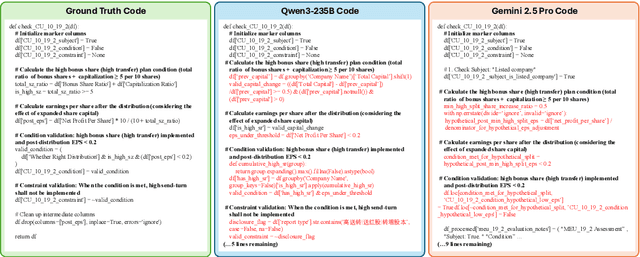
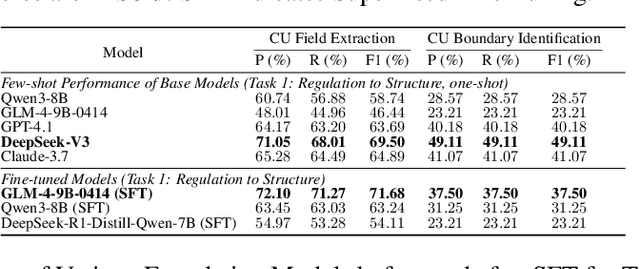


Abstract:Nowadays, regulatory compliance has become a cornerstone of corporate governance, ensuring adherence to systematic legal frameworks. At its core, financial regulations often comprise highly intricate provisions, layered logical structures, and numerous exceptions, which inevitably result in labor-intensive or comprehension challenges. To mitigate this, recent Regulatory Technology (RegTech) and Large Language Models (LLMs) have gained significant attention in automating the conversion of regulatory text into executable compliance logic. However, their performance remains suboptimal particularly when applied to Chinese-language financial regulations, due to three key limitations: (1) incomplete domain-specific knowledge representation, (2) insufficient hierarchical reasoning capabilities, and (3) failure to maintain temporal and logical coherence. One promising solution is to develop a domain specific and code-oriented datasets for model training. Existing datasets such as LexGLUE, LegalBench, and CODE-ACCORD are often English-focused, domain-mismatched, or lack fine-grained granularity for compliance code generation. To fill these gaps, we present Compliance-to-Code, the first large-scale Chinese dataset dedicated to financial regulatory compliance. Covering 1,159 annotated clauses from 361 regulations across ten categories, each clause is modularly structured with four logical elements-subject, condition, constraint, and contextual information-along with regulation relations. We provide deterministic Python code mappings, detailed code reasoning, and code explanations to facilitate automated auditing. To demonstrate utility, we present FinCheck: a pipeline for regulation structuring, code generation, and report generation.
Modality-Guided Dynamic Graph Fusion and Temporal Diffusion for Self-Supervised RGB-T Tracking
May 06, 2025Abstract:To reduce the reliance on large-scale annotations, self-supervised RGB-T tracking approaches have garnered significant attention. However, the omission of the object region by erroneous pseudo-label or the introduction of background noise affects the efficiency of modality fusion, while pseudo-label noise triggered by similar object noise can further affect the tracking performance. In this paper, we propose GDSTrack, a novel approach that introduces dynamic graph fusion and temporal diffusion to address the above challenges in self-supervised RGB-T tracking. GDSTrack dynamically fuses the modalities of neighboring frames, treats them as distractor noise, and leverages the denoising capability of a generative model. Specifically, by constructing an adjacency matrix via an Adjacency Matrix Generator (AMG), the proposed Modality-guided Dynamic Graph Fusion (MDGF) module uses a dynamic adjacency matrix to guide graph attention, focusing on and fusing the object's coherent regions. Temporal Graph-Informed Diffusion (TGID) models MDGF features from neighboring frames as interference, and thus improving robustness against similar-object noise. Extensive experiments conducted on four public RGB-T tracking datasets demonstrate that GDSTrack outperforms the existing state-of-the-art methods. The source code is available at https://github.com/LiShenglana/GDSTrack.
Gemini Robotics: Bringing AI into the Physical World
Mar 25, 2025Abstract:Recent advancements in large multimodal models have led to the emergence of remarkable generalist capabilities in digital domains, yet their translation to physical agents such as robots remains a significant challenge. This report introduces a new family of AI models purposefully designed for robotics and built upon the foundation of Gemini 2.0. We present Gemini Robotics, an advanced Vision-Language-Action (VLA) generalist model capable of directly controlling robots. Gemini Robotics executes smooth and reactive movements to tackle a wide range of complex manipulation tasks while also being robust to variations in object types and positions, handling unseen environments as well as following diverse, open vocabulary instructions. We show that with additional fine-tuning, Gemini Robotics can be specialized to new capabilities including solving long-horizon, highly dexterous tasks, learning new short-horizon tasks from as few as 100 demonstrations and adapting to completely novel robot embodiments. This is made possible because Gemini Robotics builds on top of the Gemini Robotics-ER model, the second model we introduce in this work. Gemini Robotics-ER (Embodied Reasoning) extends Gemini's multimodal reasoning capabilities into the physical world, with enhanced spatial and temporal understanding. This enables capabilities relevant to robotics including object detection, pointing, trajectory and grasp prediction, as well as multi-view correspondence and 3D bounding box predictions. We show how this novel combination can support a variety of robotics applications. We also discuss and address important safety considerations related to this new class of robotics foundation models. The Gemini Robotics family marks a substantial step towards developing general-purpose robots that realizes AI's potential in the physical world.
Fixed Point Computation: Beating Brute Force with Smoothed Analysis
Jan 18, 2025Abstract:We propose a new algorithm that finds an $\varepsilon$-approximate fixed point of a smooth function from the $n$-dimensional $\ell_2$ unit ball to itself. We use the general framework of finding approximate solutions to a variational inequality, a problem that subsumes fixed point computation and the computation of a Nash Equilibrium. The algorithm's runtime is bounded by $e^{O(n)}/\varepsilon$, under the smoothed-analysis framework. This is the first known algorithm in such a generality whose runtime is faster than $(1/\varepsilon)^{O(n)}$, which is a time that suffices for an exhaustive search. We complement this result with a lower bound of $e^{\Omega(n)}$ on the query complexity for finding an $O(1)$-approximate fixed point on the unit ball, which holds even in the smoothed-analysis model, yet without the assumption that the function is smooth. Existing lower bounds are only known for the hypercube, and adapting them to the ball does not give non-trivial results even for finding $O(1/\sqrt{n})$-approximate fixed points.
Facial Action Unit Detection by Adaptively Constraining Self-Attention and Causally Deconfounding Sample
Oct 02, 2024Abstract:Facial action unit (AU) detection remains a challenging task, due to the subtlety, dynamics, and diversity of AUs. Recently, the prevailing techniques of self-attention and causal inference have been introduced to AU detection. However, most existing methods directly learn self-attention guided by AU detection, or employ common patterns for all AUs during causal intervention. The former often captures irrelevant information in a global range, and the latter ignores the specific causal characteristic of each AU. In this paper, we propose a novel AU detection framework called AC2D by adaptively constraining self-attention weight distribution and causally deconfounding the sample confounder. Specifically, we explore the mechanism of self-attention weight distribution, in which the self-attention weight distribution of each AU is regarded as spatial distribution and is adaptively learned under the constraint of location-predefined attention and the guidance of AU detection. Moreover, we propose a causal intervention module for each AU, in which the bias caused by training samples and the interference from irrelevant AUs are both suppressed. Extensive experiments show that our method achieves competitive performance compared to state-of-the-art AU detection approaches on challenging benchmarks, including BP4D, DISFA, GFT, and BP4D+ in constrained scenarios and Aff-Wild2 in unconstrained scenarios. The code is available at https://github.com/ZhiwenShao/AC2D.
OrientedFormer: An End-to-End Transformer-Based Oriented Object Detector in Remote Sensing Images
Sep 29, 2024Abstract:Oriented object detection in remote sensing images is a challenging task due to objects being distributed in multi-orientation. Recently, end-to-end transformer-based methods have achieved success by eliminating the need for post-processing operators compared to traditional CNN-based methods. However, directly extending transformers to oriented object detection presents three main issues: 1) objects rotate arbitrarily, necessitating the encoding of angles along with position and size; 2) the geometric relations of oriented objects are lacking in self-attention, due to the absence of interaction between content and positional queries; and 3) oriented objects cause misalignment, mainly between values and positional queries in cross-attention, making accurate classification and localization difficult. In this paper, we propose an end-to-end transformer-based oriented object detector, consisting of three dedicated modules to address these issues. First, Gaussian positional encoding is proposed to encode the angle, position, and size of oriented boxes using Gaussian distributions. Second, Wasserstein self-attention is proposed to introduce geometric relations and facilitate interaction between content and positional queries by utilizing Gaussian Wasserstein distance scores. Third, oriented cross-attention is proposed to align values and positional queries by rotating sampling points around the positional query according to their angles. Experiments on six datasets DIOR-R, a series of DOTA, HRSC2016 and ICDAR2015 show the effectiveness of our approach. Compared with previous end-to-end detectors, the OrientedFormer gains 1.16 and 1.21 AP$_{50}$ on DIOR-R and DOTA-v1.0 respectively, while reducing training epochs from 3$\times$ to 1$\times$. The codes are available at https://github.com/wokaikaixinxin/OrientedFormer.
Spatial-Frequency Dual Progressive Attention Network For Medical Image Segmentation
Jun 12, 2024Abstract:In medical images, various types of lesions often manifest significant differences in their shape and texture. Accurate medical image segmentation demands deep learning models with robust capabilities in multi-scale and boundary feature learning. However, previous networks still have limitations in addressing the above issues. Firstly, previous networks simultaneously fuse multi-level features or employ deep supervision to enhance multi-scale learning. However, this may lead to feature redundancy and excessive computational overhead, which is not conducive to network training and clinical deployment. Secondly, the majority of medical image segmentation networks exclusively learn features in the spatial domain, disregarding the abundant global information in the frequency domain. This results in a bias towards low-frequency components, neglecting crucial high-frequency information. To address these problems, we introduce SF-UNet, a spatial-frequency dual-domain attention network. It comprises two main components: the Multi-scale Progressive Channel Attention (MPCA) block, which progressively extract multi-scale features across adjacent encoder layers, and the lightweight Frequency-Spatial Attention (FSA) block, with only 0.05M parameters, enabling concurrent learning of texture and boundary features from both spatial and frequency domains. We validate the effectiveness of the proposed SF-UNet on three public datasets. Experimental results show that compared to previous state-of-the-art (SOTA) medical image segmentation networks, SF-UNet achieves the best performance, and achieves up to 9.4\% and 10.78\% improvement in DSC and IOU. Codes will be released at https://github.com/nkicsl/SF-UNet.
Efficient Decoder for End-to-End Oriented Object Detection in Remote Sensing Images
Dec 02, 2023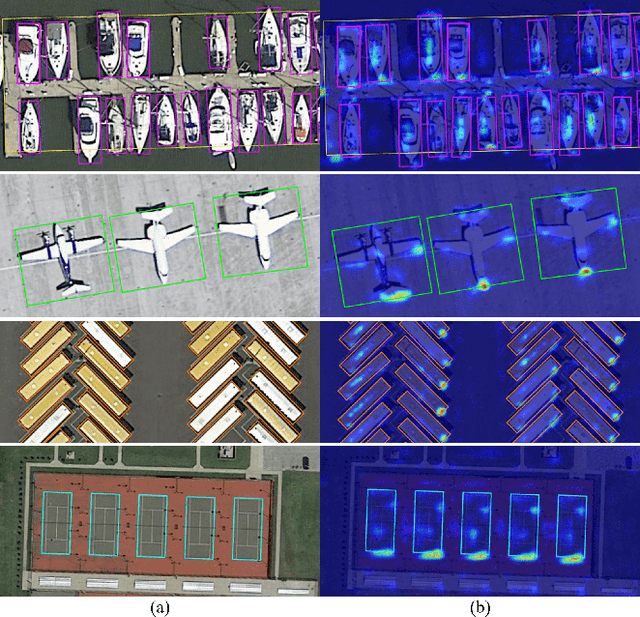
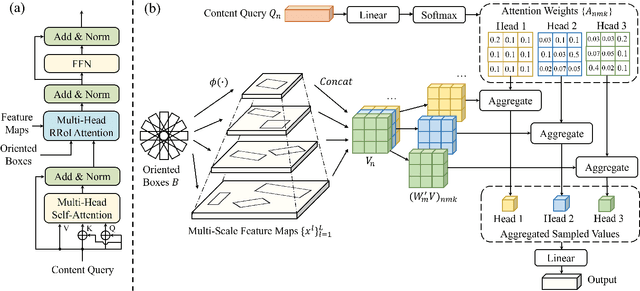
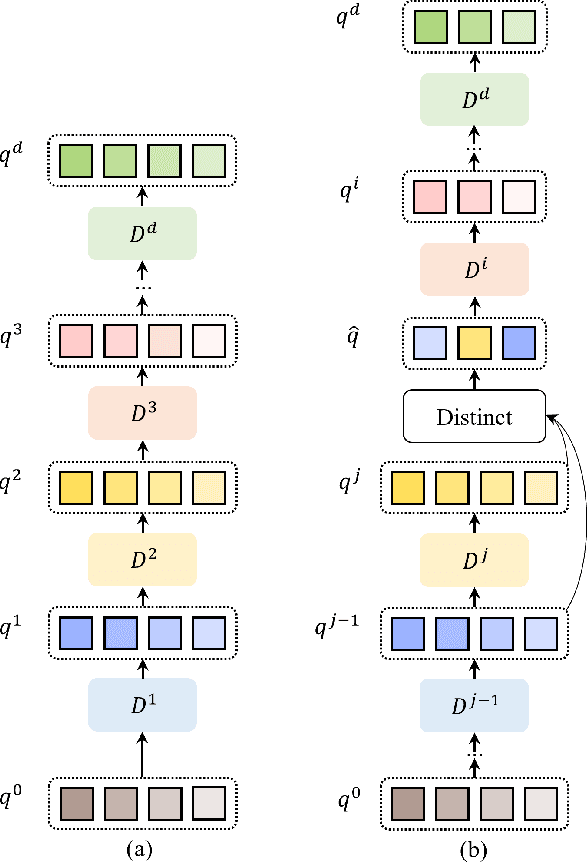
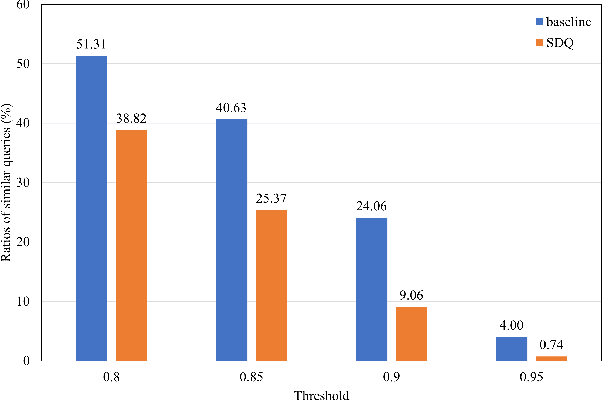
Abstract:Object instances in remote sensing images often distribute with multi-orientations, varying scales, and dense distribution. These issues bring challenges to end-to-end oriented object detectors including multi-scale features alignment and a large number of queries. To address these limitations, we propose an end-to-end oriented detector equipped with an efficient decoder, which incorporates two technologies, Rotated RoI attention (RRoI attention) and Selective Distinct Queries (SDQ). Specifically, RRoI attention effectively focuses on oriented regions of interest through a cross-attention mechanism and aligns multi-scale features. SDQ collects queries from intermediate decoder layers and then filters similar queries to obtain distinct queries. The proposed SDQ can facilitate the optimization of one-to-one label assignment, without introducing redundant initial queries or extra auxiliary branches. Extensive experiments on five datasets demonstrate the effectiveness of our method. Notably, our method achieves state-of-the-art performance on DIOR-R (67.31% mAP), DOTA-v1.5 (67.43% mAP), and DOTA-v2.0 (53.28% mAP) with the ResNet50 backbone.
Dynamic V2X Autonomous Perception from Road-to-Vehicle Vision
Oct 29, 2023Abstract:Vehicle-to-everything (V2X) perception is an innovative technology that enhances vehicle perception accuracy, thereby elevating the security and reliability of autonomous systems. However, existing V2X perception methods focus on static scenes from mainly vehicle-based vision, which is constrained by sensor capabilities and communication loads. To adapt V2X perception models to dynamic scenes, we propose to build V2X perception from road-to-vehicle vision and present Adaptive Road-to-Vehicle Perception (AR2VP) method. In AR2VP,we leverage roadside units to offer stable, wide-range sensing capabilities and serve as communication hubs. AR2VP is devised to tackle both intra-scene and inter-scene changes. For the former, we construct a dynamic perception representing module, which efficiently integrates vehicle perceptions, enabling vehicles to capture a more comprehensive range of dynamic factors within the scene.Moreover, we introduce a road-to-vehicle perception compensating module, aimed at preserving the maximized roadside unit perception information in the presence of intra-scene changes.For inter-scene changes, we implement an experience replay mechanism leveraging the roadside unit's storage capacity to retain a subset of historical scene data, maintaining model robustness in response to inter-scene shifts. We conduct perception experiment on 3D object detection and segmentation, and the results show that AR2VP excels in both performance-bandwidth trade-offs and adaptability within dynamic environments.
 Add to Chrome
Add to Chrome Add to Firefox
Add to Firefox Add to Edge
Add to Edge